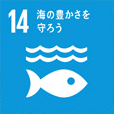welcome to The Sea Thrtle’s World
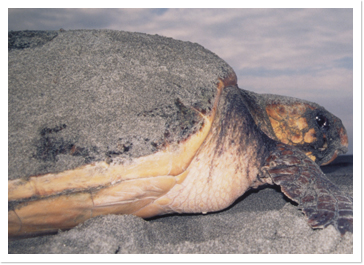
Turtles have been living on this planet from two hundred million years ago.
Their history goes back much further than that of humans.
There are eight species of SEA TURTLES in the world.
Mainly three species can be found in the oceans surrounding Japan; Green turtles, Hawksbill turtles, and Loggerhead turtles.
Out of three, Loggerhead turtles come to these beaches to lay their eggs.
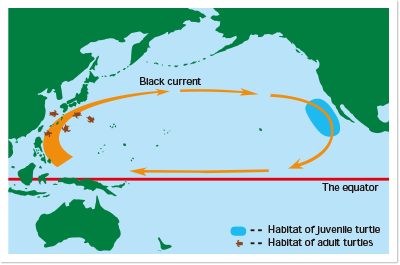
- The Pacific current and Loggerhead turtles
- After hatching, juvenile loggerhead turtles make a circular tour of the black current. Many kinds of food are found in this warm current; fish, shellfish, jellyfish, etc. Reaching maturity the new adults return across the Pacific on the current. In the spring, the black current moves north to the southern coast of Japan bringing the adult turtles along with it. The Ensyunada beaches become an important egg laying area from May to August. About two months after the eggs are laid, they will begin hatching. As fall approaches the black current again moves away from the coast of Japan taking the hatchlings across the Pacific.
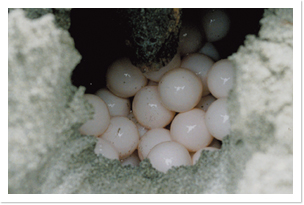
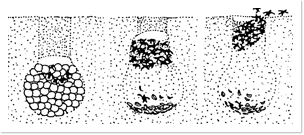
- Laying eggs
- Turtles wait offshore at night, until the beach is quiet. Once the conditions are calm, they come ashore to lay their eggs. The female turtle digs a hole about 60cm(23in.) deep in the sand using her hind fins. A female will lay an average of 110 soft shelled white eggs of about 4cm in diameter (almost the same size as a Ping-Pong ball). After burying the eggs, she covers the nest with sand using her fore fins, and returns to the ocean. This entire procedure sometimes requires over two hours to complete. Females lay eggs every two or three years, they don't breed annually. One female turtle will lay eggs around three times a season. More than 100 turtles land in the 110km(70miles) Ensyunada area in an average year, a maximum of 600 nests has been counted.
- Hatching
- Hatching starts about two months after laying. Like a chain reaction, the shells split open. The crumpled shells make some open space to allow the hatchlings to move the sand above them. When most of the eggs finish hatching, the hatchlings start burrowing their way through the sand in unison. The sand above them is moved below providing the hatchlings with a higher footing to go forward. The hatchlings seem to gush forth from the sand's surface. This cooperative work is carried out at night. They can tell it's night by the temperature of the sand. The hatchlings make their way to the ocean, possibly using ultra-violet light emitted from the sea as their guide. They will never know or meet their parents. Only one out a couple of thousand hatchlings will survive long enough to become an adult.
World Sea Turtles
- Sea turtles in peril
- All sea turtle species are endangered. They are over hunted in the world for meat, oil, tortoiseshell crafts, stuffed turtles, etc. The turtle's living environment has changed. Garbage is drifting even in the middle of the Pacific. Many turtles die by eating plastic bags or rubber balloons which are confused with their favorite food, the jelly fish.
Loggerhead turtle's eggs are often robbed from these beaches even though the taking of eggs is prohibited. Hatchlings are traded at some pet shops. Eggs are sometimes sold to special restaurants. Sea turtles in peril All sea turtle species are endangered. They are over hunted in the world for meat, oil, tortoiseshell crafts, stuffed turtles, etc. The turtle's living environment has changed. Garbage is drifting even in the middle of the Pacific. Many turtles die by eating plastic bags or rubber balloons which are confused with their favorite food, the jelly fish.
Loggerhead turtle's eggs are often robbed from these beaches even though the taking of eggs is prohibited. Hatchlings are traded at some pet shops. Eggs are sometimes sold to special restaurants.
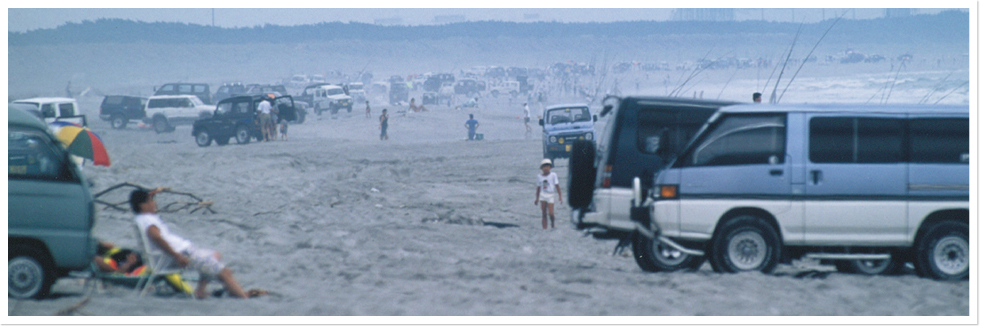
- The destruction of the Loggerhead turtle's nesting place
- The number of offroad vehicles on Ensyunada beaches has drastically increased. Fishing, surfing, swimming, etc. Almost every vehicle is for pleasure. The beach is lit up by headlights, young people are playing with fireworks until late at night. Turtles like calm, dark beaches, so because of the commotion they return to the ocean without laying eggs. An average Loggerhead turtle is over 1m(40in.) in length and about 150kg(330lbs.) in weight. They expend a lot of energy laying eggs not to mention crawling on a flat sandy beach is tiring with such a huge body. Deep ruts left by vehicles sometimes make their return to the sea impossible. Now, vehicles are prohibited on only a 25km (15miles) stretch of beach however, vehicles in other areas are not yet regulated. The beaches are also clogged with garbage which is destroying the turtle breeding area.
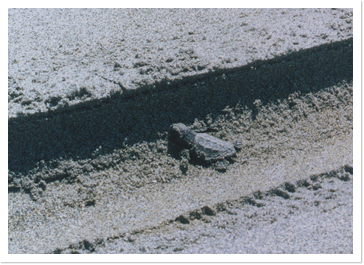
- The hatchling's destiny
- After the strenuous labor of laying the eggs, there is still a great danger of the eggs being crushed by vehicles running on the beach. When the eggs finally hatch, the deep ruts left by vehicles become high peaks and deep canyons to the hatchlings on their trek to the sea. They may also loose their sense of direction due to road and city lights. The destiny of many hatchlings will be eaten by crows or dried up on the sand.

- Preservation
- SANCTUARY N.P.O. investigates turtle laying activity every day from May to August. Several rangers patrol along these beaches in the early morning to look for turtle tracks. Sometime we encounter turtles stuck in ruts. We help them back to the ocean. When we find their tracks, we check to see if eggs were laid. If eggs are discovered, they are relocated in one of two specially protected areas on the beach. The rangers re-bury the eggs there, just as the turtle would.
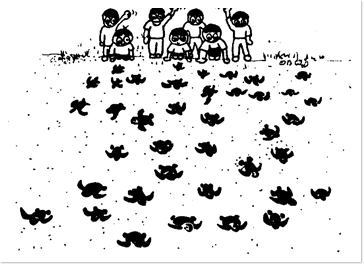
- Release
- Hatching continues almost every day from mid August to early October. Release meetings are held with participants releasing baby turtles. Only 6cm(2.5in.) in length, one of these hatchlings starts on a journey into the open ocean from your hands. If your hatchling is male, he will never come ashore again. If yours is female, she will return to lay eggs about 20 years from now. We must make this beach a safer and more beautiful place before their return.

- SANCTUARY NATURE CENTER
- TEL.053-444-5539 FAX.053-443-0904
1672-3 Nakatajima-cho, Hamamatsu-shi, Shizuoka-ken, 430-0845 JAPAN
Releasing of the sea turtles
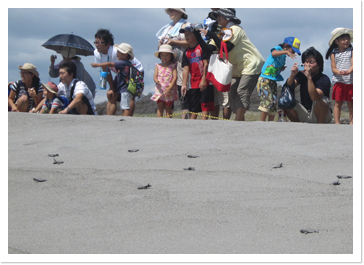
- Release
- At the sand dunes on the Hamamatsu coast, is one of the few places on the earth you can witness the phenomenon of Loggerhead Sea Turtles hatching, and then being released into the Pacific Ocean.From late summer August to October the babies hatch, the start of the season is a race to the ocean and once the first baby is hatched it’s a non stop procession for the next couple of months.The mature females return from thousands of miles away to the beach where they hatched and lay their eggs and the cycle of nature continues,the turtles are true Hamamatsu locals .We aim to protect and conserve them for future generations.

- EVENT INFOMATION
-
This event is held every year from mid-August to September.
These releasing days are held only on weekends and Japanese public holidays.
Please check the top page for the status of the event.
*Reception will start from 3:00pm and the event will begin at 3:30pm and return at 5:30pm.
The meeting place is Sanctuary Nature Center at Nakatajima.
Please take by your car or taxi or bus no.4 from stand no.6 at the bus terminal to Nakatajima.
After reception and recture , you need to go to the beach by yourself.
- HOW TO JOIN
-
This year, the fee for each event is 1,000 yen. (includes accident insurance)
The fee is subject to change without notice.
Applications should be submitted by form by noon on the day of the event.
Please feel free to contact us and ask any questions on 053-444-5539
- PERSONAL INFORMATION
- You personal information is used only for the event and our publications.
*We may take some snapshots during the event so if you do not wish to have your photo taken, please let us know.
- ACCIDENT INSURANCE
- We always aim to hold events with the utmost safety, in the case that you should be injured you will be covered by our accident insurance.
Our insurance doesn’t cover an incident involving personal injury, a natural disaster and or a radiation accident.
When traveling in our staff car you will be covered by their voluntary insurance.
**If anything unexpected may occur ,the event may be called off.
Please feel free to get information on 053-444-5539.
 arrow
arrow arrow
arrow





